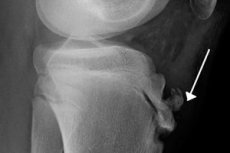Medical expert of the article
New publications
Schlatter's osteochondropathy.
Last reviewed: 05.07.2025

All iLive content is medically reviewed or fact checked to ensure as much factual accuracy as possible.
We have strict sourcing guidelines and only link to reputable media sites, academic research institutions and, whenever possible, medically peer reviewed studies. Note that the numbers in parentheses ([1], [2], etc.) are clickable links to these studies.
If you feel that any of our content is inaccurate, out-of-date, or otherwise questionable, please select it and press Ctrl + Enter.

Aseptic destruction of the tuberosity and nucleus of the tibia is Schlatter's osteochondropathy. The disease occurs against the background of long-term trauma to the musculoskeletal system during the period of intensive skeletal growth. This pathology is encountered by adolescent patients, mainly males, due to increased physical activity.
Causes osteochondropathies
The tibia is a tubular bone, its cartilaginous growth zones are located near the epiphyses. In children and adolescents, due to age-related features of the cartilaginous structure, these zones are not strong, so they are vulnerable to injuries and excessive loads. A tendon is attached to the cartilaginous growth zone - the quadriceps muscle of the thigh. It contracts with any movements involving the legs.
Increased activity can cause a tendon rupture and damage to the cartilaginous tissue of the tibia. This leads to inflammation and swelling of the tendon attachment area. Gradually, the body closes the defect with bone tissue, the excess of which manifests itself in the formation of a bone lump. That is, the main cause of the degenerative-dystrophic process in bones is injuries, which most often occur due to professional sports.
 [ 1 ]
[ 1 ]
Symptoms osteochondropathies
Symptoms of the disease:
- Pain in the lower part of the knee joint.
- Swelling in the area of the tibial tuberosity.
- Tightness in the thigh muscles.
- Pain along the tendon.
- Formation of a bony lump under the kneecap.
The intensity of pain depends on the degree of damage to the cartilage tissue and the threshold of pain sensitivity. The above symptoms can persist from several weeks to months.
Treatment osteochondropathies
Treatment consists of a set of conservative methods: rest, the most gentle motor regime, exercise therapy and physiotherapy. Medication treatment is also carried out, which includes anti-inflammatory drugs, analgesics, and multivitamin complexes.

